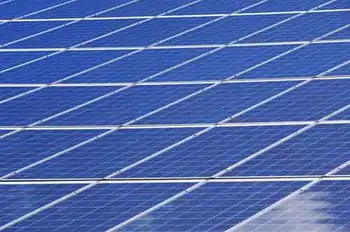Organic photovoltaics promise better efficiency
Plastic solar cells are made up of layers of different materials, each with a specific function, in what is called a sandwich structure.
Jillian Buriak, a professor of chemistry at Alberta, NINT principal investigator and member of the research team, uses a homely analogy to describe their approach: “Consider it as a multilayered clubhouse sandwich,” she said. “One layer absorbs light, another helps generate electricity, and others help separate the charges and get them to their respective electrodes. Generally, these layers don’t stick together well, so the electricity is never produced or doesn’t leave the device. We’re working on the ‘mayonnaise,’ ‘mustard,’ ‘butter’ and other ‘special sauces’ that will bring the sandwich together and make the layers work together, producing a better solar cell.”
Buriak sees a great future for organic photovoltaics.
“If you’re making organic solar cells, you’re no longer working with beautiful silicon, a single material that can do many things, such as p-n junction photocells. Plastics don’t do it all, so you must layer different plastic materials with various organic polymers on top of each other — like mustard, mayonnaise and lettuce — one helping to improve the interface with the next layer.”
The accomplishment lies in taking known materials recognized as working in the making of solar cells and experimenting to improve them.
“Solar cells are all about electric charges, and when you layer one on top of another there are hot spots,” Buriak said. “It’s like when you look at your sandwich and notice that the lettuce does not make an even contact with the bread and only touches on a couple of spots. Something similar happens with the plastic, where all these charges file through these hot spots, while the rest of the structure does nothing.”
The researchers found out how to “flatten the lettuce,” making charges more uniform, enabling the use of whole structures instead of a few hot spots that lead to bottlenecks.
“We did surface chemistry to modify the property of the transparent conductive electrode with a very thin ( The group investigated the generation and characterization of a robust thienylsilane molecular layer on indium tin oxide (ITO) substrates. The researchers discovered that the molecular layer reduced the oxidation potential required for the electrochemical polymerization of 3,4-ethylenedioxythiophene. The resulting electrochemically prepared poly (3,4-ethylenedioxythiophene):poly(p-styrenesulfonate) (ePEDOT:PSS) films provided high uniformity in their coverage, exhibiting lower roughness and higher conductivity than analogous films fabricated with bare ITO.
A relative improvement in the efficiency of 2,5-diyl-poly(3-hexylthiophene) (P3HT)/[6,6]-phenyl-C61-butyric acid methyl ester (PCBM) bulk heterojunction solar cells was obtained when devices were formed on thienylsilane-modified ITO electrodes, rather than unmodified ITO control electrodes.
The efficiency is not exactly mind-boggling.
The world record with silicon cells is 24-28%. Organic solar cells might never reach that level; they are at Because these “With polymers you can do anything you want,” Buriak said. “You’re not stuck with a single element that does what it wants. Polymers can be engineered to your needs, because with organic chemistry you can make just anything that you can think of from scratch and design into it what you want. Tailoring these interfaces with thin, subnanometer layers has profound effects on device performance. We hope that by taking a closer look at those interfaces, and spreading our ‘mayonnaise’ a little better, we’ll attain dramatic effects.”
The researchers have achieved a proof of principle, an important approach even though many improvements remain to be made. After two years of research the Canadian scientists obtained improvements of ~30% in the working modelÂ’s efficiency. The team is cross-disciplinary, with members from engineering physics and chemistry backgrounds all working toward the goal of cheap, manufacturable PV cells. The researchers predict that this multidisciplinary approach will enable plastic PV panels to be mass-produced in five to seven years, making solar energy available to everyone.
“The next generation of solar technology belongs to plastic,” Buriak said, adding that plastic solar cell material will be made cheaply and quickly and in massive quantities using inkjet-like printers. As for the future, Buriak said, “We’ve a lot of layers to fiddle with; we have to add other mustard and mayo layers. We’re tailoring each interface one at a time.”
Related News

How Energy Use Has Evolved Throughout U.S. History
WASHINGTON - The evolution of energy use in the United States is a dynamic narrative that reflects technological advancements, economic shifts, environmental awareness, and societal changes over time. From the nation's early reliance on wood and coal to the modern era dominated by oil, natural gas, and renewable sources, the story of energy consumption in the U.S. is a testament to innovation and adaptation.
Early Energy Sources: Wood and Coal
In the early days of U.S. history, energy needs were primarily met through renewable resources such as wood for heating and cooking. As industrialization took hold in the 19th century,…





